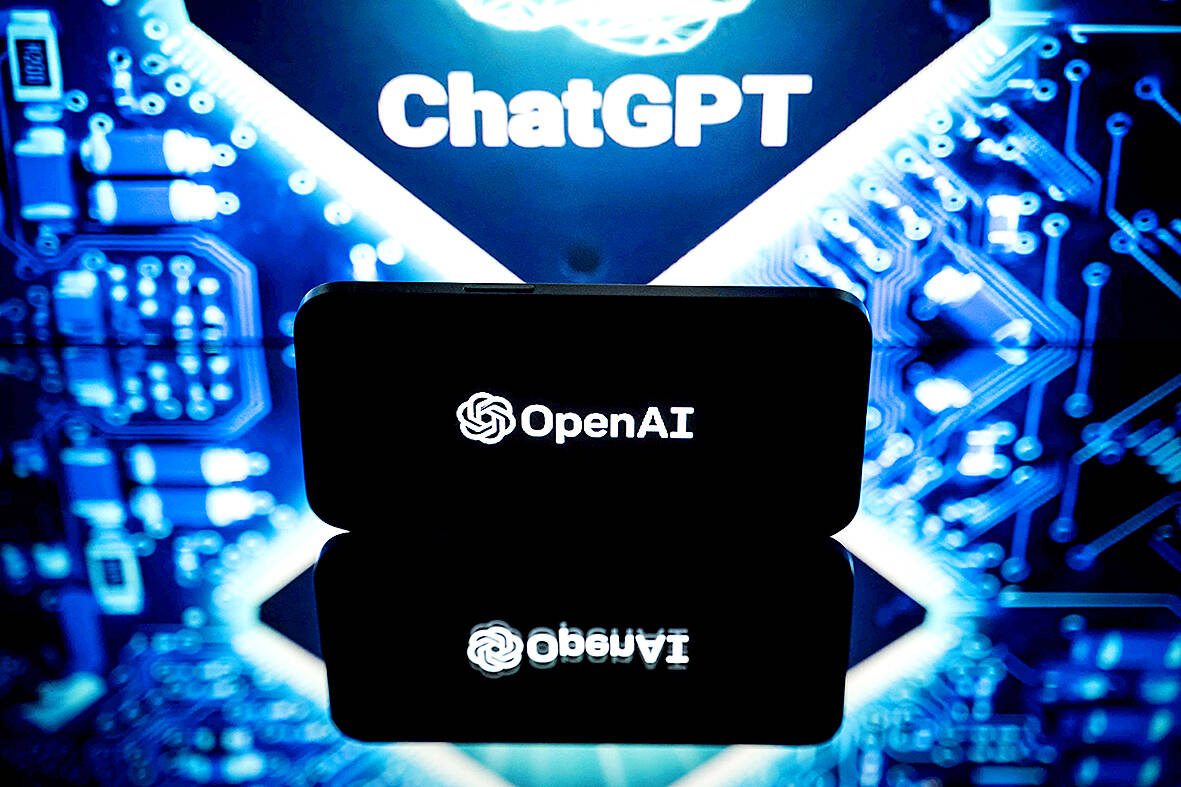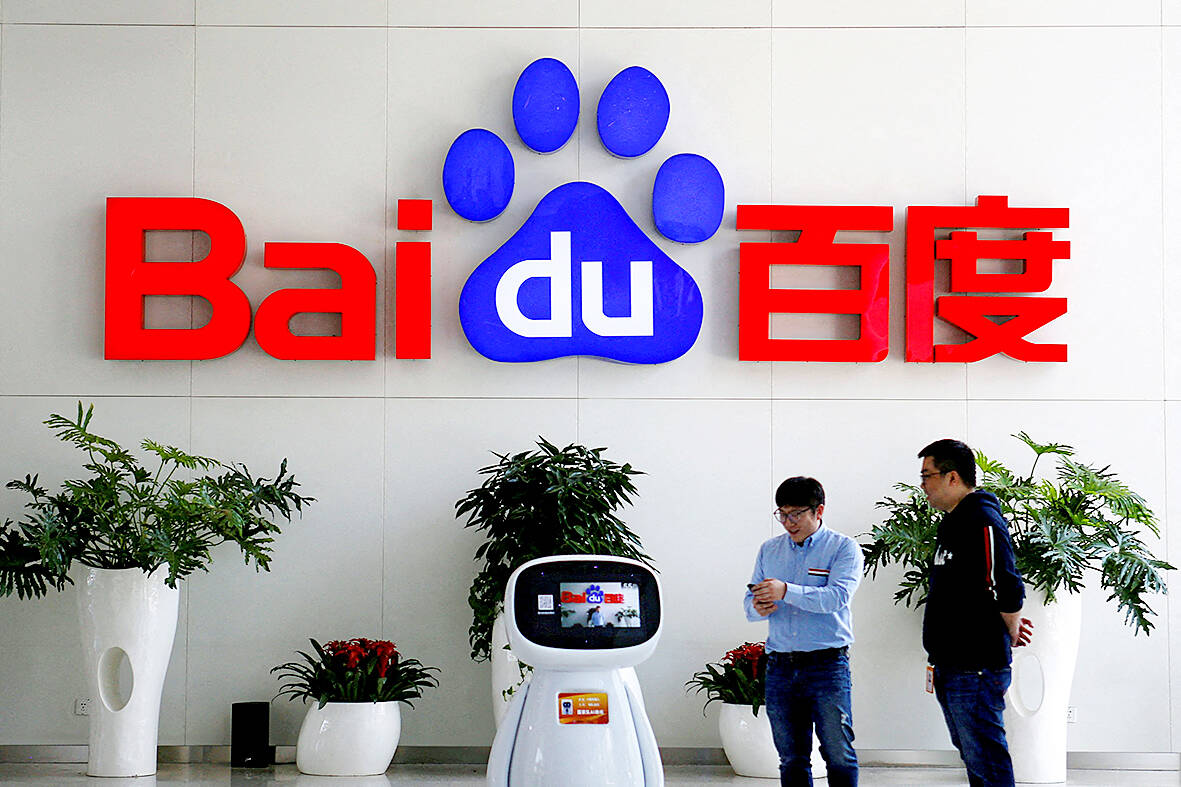Search giant Baidu’s lacklustre unveiling of its chatbot exposed gaps in China’s race to rival ChatGPT, as censorship and a US squeeze on chip imports have hamstrung the country’s artificial intelligence ambitions.
The highly anticipated preview of “Ernie Bot” last week was limited to a pre-recorded demonstration with simple questions to summarize the plot of a sci-fi novel and solving a straightforward algebra equation — to avoid politically and factually incorrect answers. From cloud computing to autonomous driving, none of the array of services Baidu had earlier promised its Ernie Bot could do were on display.
The firm’s shares plunged as much as 10 percent during the unveiling, although they rallied the following day on positive reviews from brokerages including Citigroup, whose analysts were among a small group of people invited to test the bot.

Photo: AFP
A flurry of Chinese companies including Alibaba, JD.com, Netease and TikTok-parent Bytedance have rushed to develop services that can mimic human speech since San Francisco-based OpenAI launched ChatGPT in November, sparking a gold rush in the market.
Google on Tuesday invited people in the US and Britain to test its AI chatbot, known as Bard, as it continues on its own push to catch up.
The popularity of ChatGPT in China — where users have to scale Beijing’s Internet firewall using virtual private networks (VPNs) and foreign phone numbers — has left Baidu and others scrambling to regain its dominance on home turf.

Photo: Reuters
“OpenAI probably spent as much time just testing GPT-4 as Baidu spent building Ernie Bot,” said Matt Sheehan, fellow at the Carnegie Endowment for International Peace.
“China’s tech ecosystem doesn’t have a tradition of funding open-ended research that doesn’t have a clear path to profitability.”
CHIP SUPPLY
Ernie Bot is fluent in Mandarin, as well as other regional languages including Hakka spoken in South China and Taiwan, and targets the Chinese market with more than one billion Internet users.
A headache for developers is Beijing’s heavy-handed censorship of anything seen as challenging the Communist Party — including a one-time purge of Winnie-the-Pooh after the cartoon bear was compared to Chinese leader Xi Jinping (習近平). When asked if the president of 10 years is “a good leader,” one of China’s best-performing publicly available ChatGPT-style models, developed by Beijing’s Tsinghua University, says: “The input may contain ethical content. Please try a different input.”
The strict restrictions on the Chinese Internet mean companies have “significantly less data resources for training purposes compared to Western competitors,” said Lauren Hurcombe, a technology lawyer at DLA Piper. Ernie Bot has not yet been launched for public use.
China has announced ambitious plans to become a global leader in the field of AI by 2030, and consultancy group McKinsey estimates the sector could add about US$600 billion every year to China’s gross domestic product by then.
Most of the growth will come from producing driverless cars, adding more robots to assembly lines and healthcare breakthroughs, according to McKinsey, and the government has also used AI to beef up its mass surveillance program.
However, Washington has moved to suffocate China’s technology ambitions, blocking through sanctions its access to high-grade chips, chipmaking equipment and software used to design semiconductors.
This has made it difficult for Chinese companies to buy chips including Nvidia’s A100 and its successor H100, considered the gold standard for large-scale AI training systems.
“There is a real question whether a domestic supply can be generated in the short term,” Hurcombe said.
AI GAP
But the effect of the US measures will take time to make a dent because Chinese companies rushed to stockpile high-end chips before Washington announced the export controls in October. Baidu has its own chip design arm, Kunlun, and the company says it is capable of mass-producing a seven-nanometer chip that is partly used to power its AI systems.
Dou Shen, head of Baidu’s AI Cloud group, shrugged off questions about the impact of the US restrictions during a call with investors in November, saying: “We think the impact is quite limited in the near future.”
For years, China has bragged about filing more artificial intelligence patent applications than the US. But the average number of citations of its patents — an indication of the importance and originality of its inventions — lagged behind the US and other developed countries in 2020 and 2021, according to Stanford University’s AI Index report last year.
The US also had twice as many AI startups as China, and had three times more private investment flowing into the sector in 2021, according to the report.
The Chinese government’s top-down approach to spurring innovation has failed to deliver results.
The Beijing Academy of Artificial Intelligence, established in 2018, introduced a ChatGPT-like product two years ago.
Wu Dao was described by its creators as “the world’s largest” AI language model with 1.75 trillion parameters, which is significantly larger than OpenAI’s previous GPT-3 model with 175 billion parameters. But it never really caught on.

May 11 to May 18 The original Taichung Railway Station was long thought to have been completely razed. Opening on May 15, 1905, the one-story wooden structure soon outgrew its purpose and was replaced in 1917 by a grandiose, Western-style station. During construction on the third-generation station in 2017, workers discovered the service pit for the original station’s locomotive depot. A year later, a small wooden building on site was determined by historians to be the first stationmaster’s office, built around 1908. With these findings, the Taichung Railway Station Cultural Park now boasts that it has

Wooden houses wedged between concrete, crumbling brick facades with roofs gaping to the sky, and tiled art deco buildings down narrow alleyways: Taichung Central District’s (中區) aging architecture reveals both the allure and reality of the old downtown. From Indigenous settlement to capital under Qing Dynasty rule through to Japanese colonization, Taichung’s Central District holds a long and layered history. The bygone beauty of its streets once earned it the nickname “Little Kyoto.” Since the late eighties, however, the shifting of economic and government centers westward signaled a gradual decline in the area’s evolving fortunes. With the regeneration of the once

The latest Formosa poll released at the end of last month shows confidence in President William Lai (賴清德) plunged 8.1 percent, while satisfaction with the Lai administration fared worse with a drop of 8.5 percent. Those lacking confidence in Lai jumped by 6 percent and dissatisfaction in his administration spiked up 6.7 percent. Confidence in Lai is still strong at 48.6 percent, compared to 43 percent lacking confidence — but this is his worst result overall since he took office. For the first time, dissatisfaction with his administration surpassed satisfaction, 47.3 to 47.1 percent. Though statistically a tie, for most

In February of this year the Taipei Times reported on the visit of Lienchiang County Commissioner Wang Chung-ming (王忠銘) of the Chinese Nationalist Party (KMT) and a delegation to a lantern festival in Fuzhou’s Mawei District in Fujian Province. “Today, Mawei and Matsu jointly marked the lantern festival,” Wang was quoted as saying, adding that both sides “being of one people,” is a cause for joy. Wang was passing around a common claim of officials of the People’s Republic of China (PRC) and the PRC’s allies and supporters in Taiwan — KMT and the Taiwan People’s Party — and elsewhere: Taiwan and